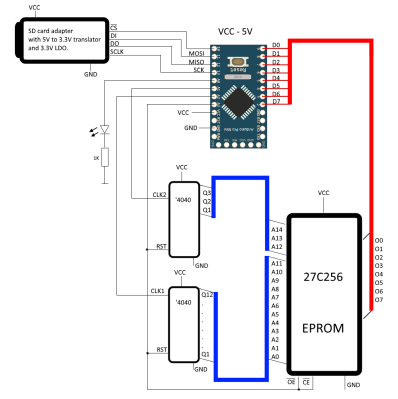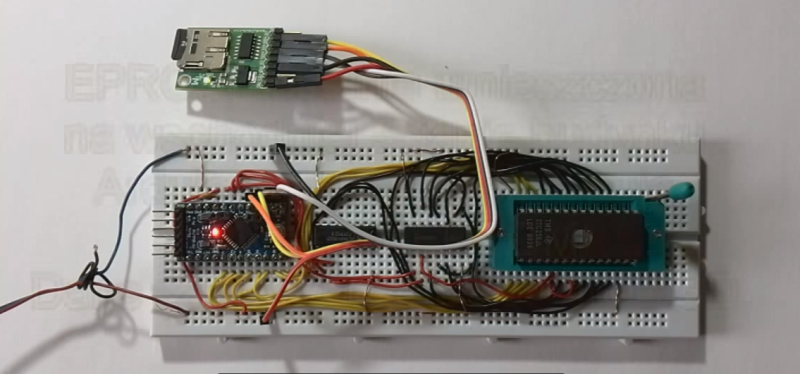Flash memory is the king today. Our microcontrollers have it embedded on the die. Phones, tablets, and computers run from flash. If you need re-writable long term storage, flash is the way to go. It hasn’t always been this way though. Only a few years ago EPROM was the only show in town. EPROM typically is burned out-of-circuit in a programming fixture. When the time comes to erase the EPROM, just pop it under an ultraviolet (UV) bulb for 30 minutes, and you’re ready to go again. The EPROM’s quartz window allows UV light to strike the silicon die, erasing the memory.
The problem arises when you want to use an EPROM for long term storage. EPROM erasers weren’t the only way to blank a chip. The sun will do it in a matter of weeks. Even flourescent light will do it — though it could take years.
 [TechEkspert] wanted to learn about the nature of erasing an EPROM with the sun, so he got out an old EPROM and started hacking. (translated link) [TechEkspert] programmed the EPROM with a known pattern of ones and zeros. A pair of 74HC4040 counters would address the entire 32 KB memory of the EPROM. An Arduino Mini read the data out, storing it in an SD card. A bit of python code translated the data to PNG files, which were then combined to render a video.
[TechEkspert] wanted to learn about the nature of erasing an EPROM with the sun, so he got out an old EPROM and started hacking. (translated link) [TechEkspert] programmed the EPROM with a known pattern of ones and zeros. A pair of 74HC4040 counters would address the entire 32 KB memory of the EPROM. An Arduino Mini read the data out, storing it in an SD card. A bit of python code translated the data to PNG files, which were then combined to render a video.
The whole setup was placed on the roof in full sun. Then the waiting began. Nothing much happened for two weeks. Then some bits started to flicker. This means that sometimes they would read as a 0, and other times a 1. The sun was starting to destroy the stored data. Right at the 3 week mark, all the remaining data quickly started to disappear. In the end the entire chip was erased.
While [TechEkspert’s] chip could be re-programmed, that’s not always the case with EEPROM and flash. Check out this EEPROM killer which calculated how many cycles it took to destroy the electronically erasable storage in an Atmel ATmega328.

















Heyyyyyyy, you could have a roof full of EPROMs to generate RNG entropy from bit rot LOL
I bought one of these to wipe some EPROMs. Worked like a champ. Took about 8 mins.
https://www.amazon.com/GermGuardian-GG1000-Pluggable-Sanitizer-Reducer/dp/B000G2BESO/ref=sr_1_4_a_it?ie=UTF8&qid=1473852778&sr=8-4&keywords=uv+air+purifier
Seems kind of expensive.
http://www.ebay.com/itm/New-High-Speed-110V-to-240V-UV-Light-Lamp-EPROM-Data-Eraser-Eraseable-Timer-/112111280074?hash=item1a1a5a5fca:g:1LEAAOSw65FXwiY2
I have this one, works fine, few minutes, and it’s done. It has clear tube, so it requires careful handling. Other thing that can be used is nail-polish dryer, they are also pretty cheap, and have much larger UV-lit area so they’re quite usable for making PCBs.
lmao get a UV light strip. in addition to erasing EPROM’s, you can shove it inside a PC case for that slick UV-reactive coolant to glow.
Here I have some interesting site information (not my own writing, though…)
https://translate.google.co.jp/translate?sl=auto&tl=en&js=y&prev=_t&hl=en&ie=UTF-8&u=https%3A%2F%2Fvintagechips.wordpress.com%2F2016%2F05%2F11%2Fepromの消去に成功%2F&edit-text=
15 hours to blank it? is this a normal timing?
In my case, it takes just 5-seconds to erase , as in this video…
https://www.youtube.com/watch?v=_sSuzDg4ntA
By the way, ’tis the season… “Black light” bulbs appear in the stores here for Hallowe’en fairly cheap.
Probably won’t work well. You need UV-B or UV-C to erase EPROMS.
I think they are UVb .. but kinda low output at 400nm so might take a while.
You need UV-B, like from a mercury arc quartz lamp, but blacklight is – as you say – 400nm. This is at the border of visible light and UV-A. You do not want – and do not get – sunburn from blacklight.
Generally you need “hard” UV to erase an EPROM. If the light won’t burn your skin, kill bacteria and other living cells, it lacks the energy for effective EPROM erasing.
Traditionally, mercury fluorescent tubes at 254nm are used, but just because that’s the cheapest, easiest thing to engineer in this UV ballpark, not because the exact wavelength is special for EEPROMs.
Ordinary nightclub blacklights won’t work. Anything with a mercury lamp, anything marketed for germicidal use, with warnings to shield your skin and eyes, should work well.
EPROMs, rather, not EEPROMs.
Given a lens, you could start taking pictures. The very first homebrew/consumer computer digital cameras relied on this effect more-or-less.
http://jalopnik.com/the-first-digital-camera-you-could-buy-was-a-total-hack-1215543300
Bad article is bad, conflating DRAM with EEPROM.
Dammit, EPROM, fingers stuttered. EEPROM different.
This is the electronic equivalent of watching paint dry.
But microcontrollers have much more patience than humans. :-)
I happened to find a Donkey Machine machine being thrown out next to a dumpster, so I snatched it up and put it in storage. It needed work, as I could clearly see the CRT neck was broken, so it was a back-burner project. When I finally got to it a few years later, I realized that the stickers had fallen off the EPROMs and the small amount of direct sunlight in the storage area had wiped all the data.
One of the early Bell Labs BLIT terminals had overheating problems. (I forget if it was the 68000 or WE32000 version.) Somebody at the Murray Hill labs implemented the standard solution for this, which was to take the back off so it could cool better. But their desk was facing the window (the building was old enough that all the offices had working windows and transoms for cooling.) After a few weeks of sunlight shining into the back of the terminal, the EPROM got erased, and the terminal forgot to be a terminal.
What’s a Donkey Machine?
Think he means a Donkey Kong arcade machine.
Ah!
I would guess that EPROMs are not infinitely erasable either (just like EEPROMs and NAND/NOR flash). But since it takes 1,230,163 cycles to kill an EEPROM, and at 3 weeks per cycle for this, I guess you get nearly 500,000 years of use out of it.
Dammit, learn to spell FLUORESCENT correctly! It’s not a frickin’ cookery show! That apart, I had a trick for erasing EPROMs many years ago, before I got a proper UV lamp. Anyone used a carbon-arc brazing torch? They have two carbon electrodes at 45 degrees, connected to an arc welder, and the arc behaves like a high-temperature flame, which you can braze with. Filthy has hell, but relatively handy if you don’t have a gas supply. They also give out gobs of UV – I found that about 5 seconds, at about a foot away from the torch, was enough to erase most EPROMs. Not exactly a lab technique, but there you go ;-)
Haha, I’ll bet leaving an EPROM near a welding table would work for me.
I use to do it in the sun for 3 days?
Perhaps the altitude? (1700m above sea level)
Different manufacturer?
Keep those labels or tape covering on those chips and covers on gear that is outdoors or even in a sunny windowed room!
I just went thru determining that 11 of 12 of these 128k EPROM’s are blown in a lightning spike hit in an organ. They’re available and we have a second set to copy, and someone to go to. They’re wave samples for the voices in the organ.
Xrays kill them too…..if the discharge was big enough.
In the early days for the IBM PC clones, the motherboards with unlabelled EPROMs would crash when a photographer took a flash picture of it. Happened enough times at trade shows.
In not so early days Rapsberry Pi exhibited thus behaviour too. The culprit was a voltage regulator in a CSP (nearly bare die flip chip).
Interesting!!! In the 90s when I couldn’t afford my own UV eraser, I did try using the sun for a few hours, but gave up and borrowed an eraser. At last, the mystery is solved :)
I used an old UV sunlamp, which I converted for PCB exposure. I had removed the IR heating element, which functioned also as the ballast for the mercury lamp and substituted it with two parallel 60W fluorescent tube chokes. As it emitted enough smell of ozone while on I preferred to leave the room instead of deliberately exposing my skin to the radiation – which was the original purpose of this lamp.
Can we add some lens and make world’s slowest digital camera?
Stick a bunch on a board with their power and ground pins daisy chained. Solar power! :) (A very small amount of solar power…)
If the EPROM was all erased, why wasn’t the pattern all yellow or all red, instead of both colors? And what was the band of color about 1/3 of the way down?
It is like a diffraction grating, or looking at a CDs reflection.
Iridescence.
No, he’s talking about the video. It used red and yellow in a diagram of the EPROM’s data. I’m not sure about that myself.
What would be the best USB programmer compatible with these EPROM available nowadays? I have an old Willem 3.1 parallel port programmer which can read them, but never managed to have it write to them correctly.
Thwy used to have a write pin that needed high voltage, like 15-20V. Didn’t use programmer,s just the parallel printer port and a string of 1.5v cells with a switch to enable writing.
I find this surprising that it would take TWO WEEKS before any bits flipped.
Thirty-five years ago, using such chips as 2716 UV-EPROM chips, we routinely erased them in 20~30 minutes in direct sunlight, on a cloudless day, on the EE building rooftop on campus. We did this routinely for months before we received our lab eraser based on a germicidal UV lamp. And the germicidal lamp would typically take 30 mintues as well.
The technology is basically the same as 27256 (in the article), so I’m puzzle at the sunlight conditions that would take TWO WEEKS as described in the article.
Two thoughts…
Firstly, it was powered on, I’m thinking that may add an additional energy barrier to overcome.
Secondly, I’m wondering if they didn’t put it in a baggie, since exposing a solderless breadboard to the elements for 2 weeks doesn’t seem like something you would do. Then we wonder about how much that plastic screened the UV.